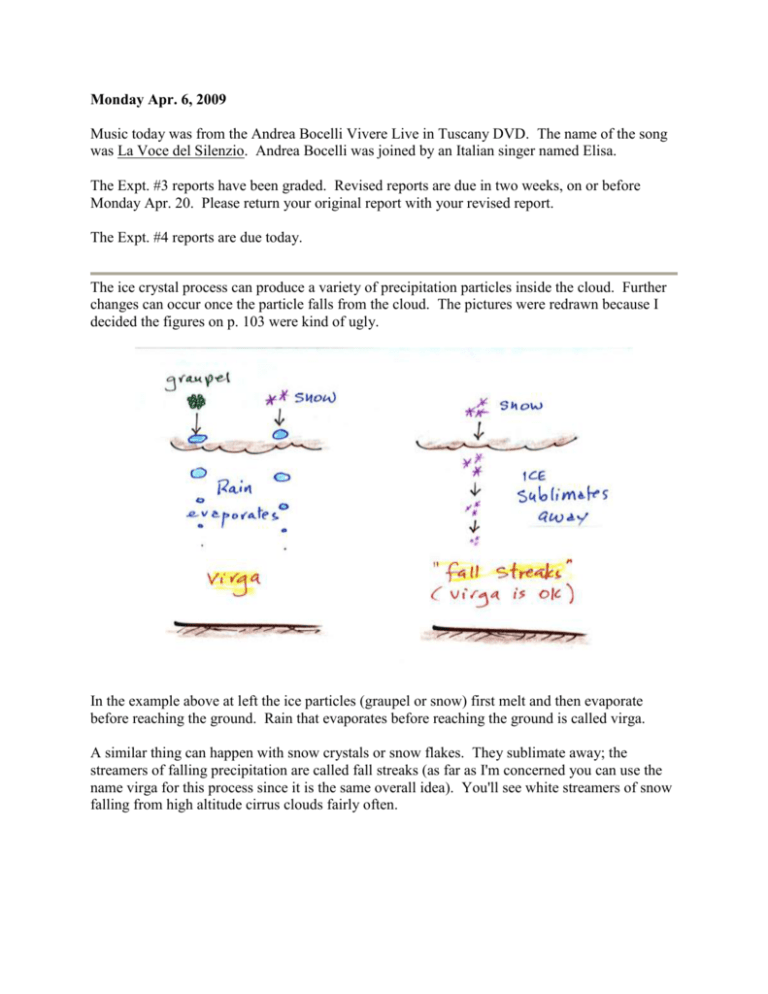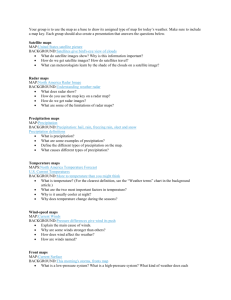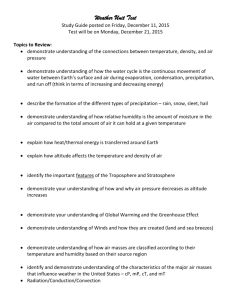here
advertisement

Monday Apr. 6, 2009 Music today was from the Andrea Bocelli Vivere Live in Tuscany DVD. The name of the song was La Voce del Silenzio. Andrea Bocelli was joined by an Italian singer named Elisa. The Expt. #3 reports have been graded. Revised reports are due in two weeks, on or before Monday Apr. 20. Please return your original report with your revised report. The Expt. #4 reports are due today. The ice crystal process can produce a variety of precipitation particles inside the cloud. Further changes can occur once the particle falls from the cloud. The pictures were redrawn because I decided the figures on p. 103 were kind of ugly. In the example above at left the ice particles (graupel or snow) first melt and then evaporate before reaching the ground. Rain that evaporates before reaching the ground is called virga. A similar thing can happen with snow crystals or snow flakes. They sublimate away; the streamers of falling precipitation are called fall streaks (as far as I'm concerned you can use the name virga for this process since it is the same overall idea). You'll see white streamers of snow falling from high altitude cirrus clouds fairly often. The frozen precipitation particles produced by the ice crystal process (graupel or snow) can melt before reaching the ground. This would be rain (or drizzle if the drops are small). This is where rain in Tucson comes from even in the summer. Rain in most locations at most times of the year starts out as frozen precipitation. If you are on a mountain top you might see some of the frozen precipitation before it melts. You might see graupel falling from a summer thunderstorm, for example, while the people in the valley only observe rain. Sometimes the graupel particles due reach the ground in Tucson. Sometimes the frozen precipitation will melt and then fall into a thick layer of cold air and refreeze. The resulting particle is called sleet (or ice pellets). Sleet is rain that freezes before hitting the ground. The clear ice in sleet is noticeably different from the frosty, milky white, rime ice in graupel. Rain that falls into a shallow cold air layer and only freezes after reaching the ground is called freezing rain. It is nearly impossible to drive during one of these "ice storms." Sometimes the coating of ice is heavy enough that branches on trees are broken and power lines are brought down. It sometimes takes several days for power to be restored. Satellite photographs are a good way of observing clouds (especially out over the ocean). Using both visible and infrared light satellite photographs, you can get a good idea of cloud type. However satellite photographs don't really tell you whether a cloud is producing precipitation or not. For that you need radar. The following information on radar was not covered in class. An ordinary radar periodically transmits a short burst of microwave radiation. This radiation penetrates a cloud but is reflected by precipitation particles. The radar keeps track of what direction the antenna is pointing and determines how long it takes for a signal to go out and return. The radar also measures the strength of the return signal (a cloud with lots of relatively large precipitation particles will produce a stronger reflection than a cloud with less and smaller particles). Conventional radar can thus determine the direction and distance to a precipitating cloud and make an estimate of the rainfall rate or intensity. The radar antenna slowly spins as it is transmitting so it scans a full 360 degrees in a minute or two. Information from a single radar or a combination of data from many radars are drawn on weather maps (the PPI display above shows the data from a single radar, the radar would be at the center of the picture). This would show where precipitation is occurring. The radar data is often combined with satellite photographs. Colors are used to indicate the intensity of the precipitation. Yellows, oranges and reds generally indicate the heaviest precipitation (often coming from thunderstorms). In research the radar can be used to scan vertically through a storm, this produces an RHI display. By detecting changes in the frequency of the reflected signal, a doppler radar can measure the speed at which precipitation particles are moving toward or away from a radar antenna. By combining data from 2 or more radars (and some complicated computer processing), threedimensional wind motions inside a cloud can be mapped out. Doppler radars can detect a rotating thunderstorm updraft (a mesocyclone) that could indicate a thunderstorm capable of producing tornadoes. Small mobile doppler radars are being used to try to measure wind speeds in tornadoes. Police use doppler radar to measure the speeds of automobiles on the highway (moving toward or away from the police car). Dual polarization radar is a research tool that can be used to learn something about the kinds of precipitation particles inside a cloud. The material on Why the Wind Blows Like it Does will be moved to the Friday Apr. 10 notes.







